Legal Analysis: Amina's Claims in Contract, Tort, and Product Law
VerifiedAdded on 2023/05/29
|14
|4974
|176
Case Study
AI Summary
This case study analyzes Amina's potential legal claims against the manufacturer or supplier of a product she purchased, focusing on contractual, tortious, product liability, and product safety issues. It discusses relevant laws such as the Sales of Goods Act 1979, the Consumer Rights Act 2015, and the Consumer Protection Act 1987. The analysis covers implied contractual terms, the tort of negligence (including duty of care, breach, and damages), and product liability for defective goods. It also explores product safety standards and the potential liabilities of manufacturers and suppliers for injuries or damages caused by their products, concluding with a summary of Amina's possible legal recourse.
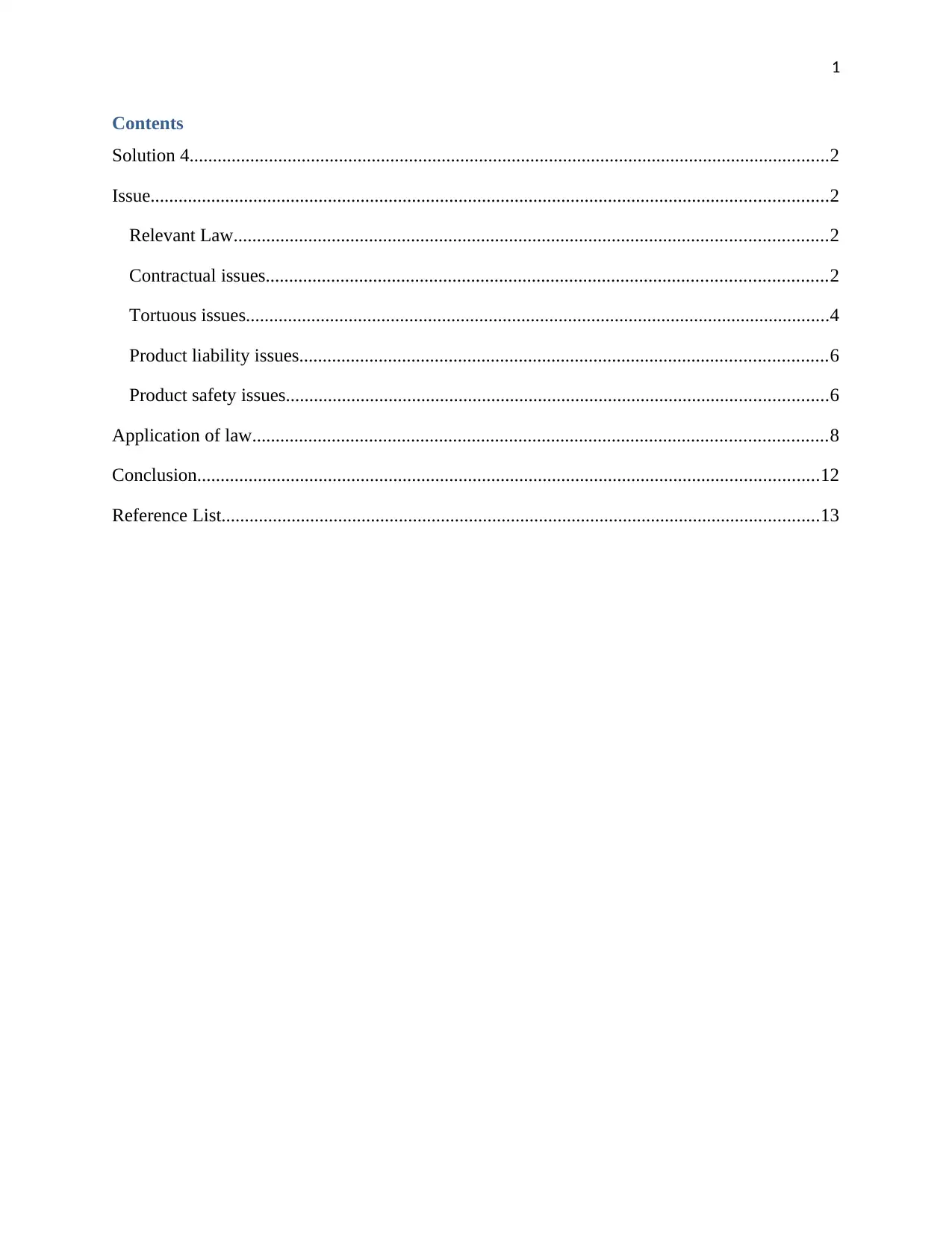
1
Contents
Solution 4.........................................................................................................................................2
Issue.................................................................................................................................................2
Relevant Law...............................................................................................................................2
Contractual issues........................................................................................................................2
Tortuous issues.............................................................................................................................4
Product liability issues.................................................................................................................6
Product safety issues....................................................................................................................6
Application of law...........................................................................................................................8
Conclusion.....................................................................................................................................12
Reference List................................................................................................................................13
Contents
Solution 4.........................................................................................................................................2
Issue.................................................................................................................................................2
Relevant Law...............................................................................................................................2
Contractual issues........................................................................................................................2
Tortuous issues.............................................................................................................................4
Product liability issues.................................................................................................................6
Product safety issues....................................................................................................................6
Application of law...........................................................................................................................8
Conclusion.....................................................................................................................................12
Reference List................................................................................................................................13
Paraphrase This Document
Need a fresh take? Get an instant paraphrase of this document with our AI Paraphraser
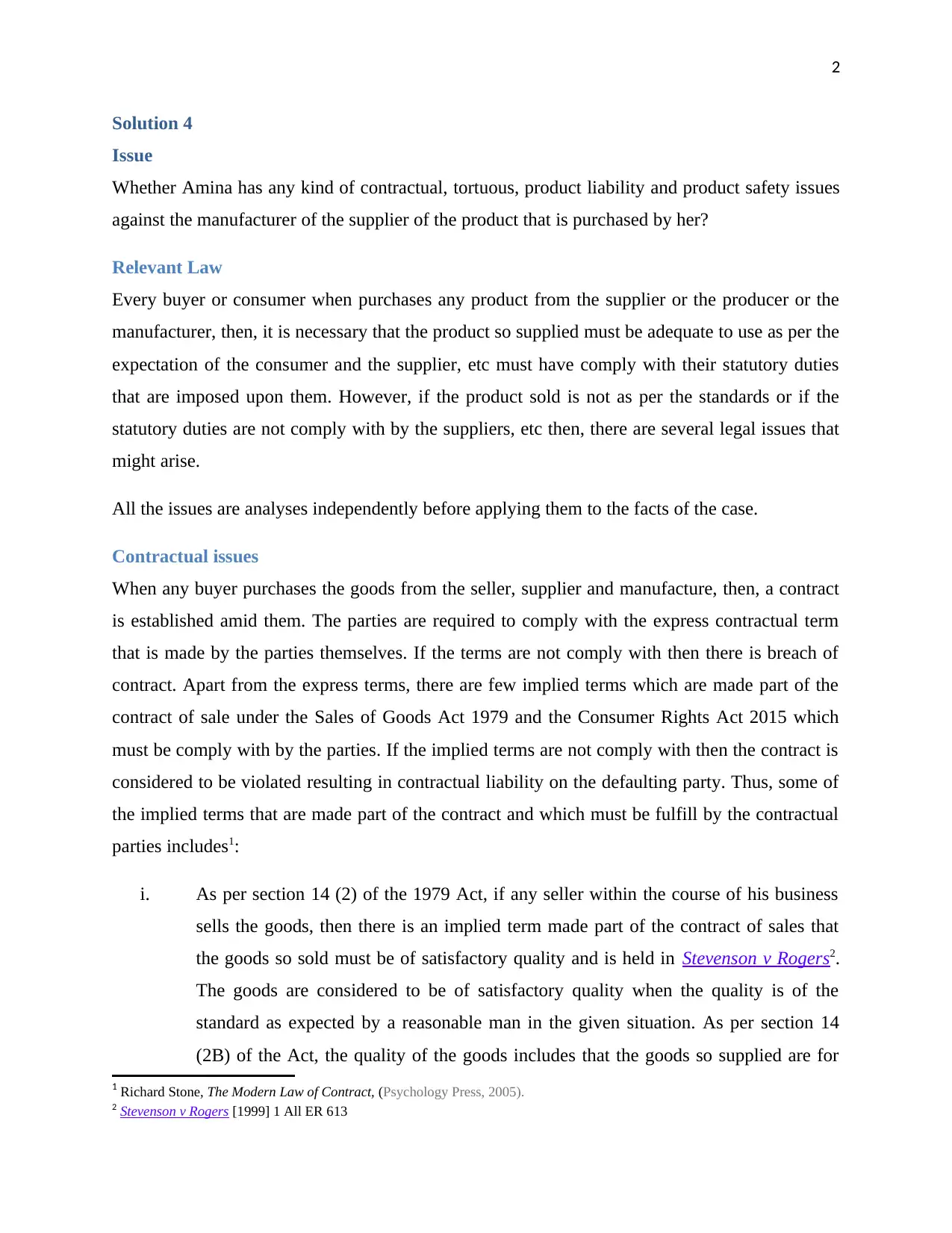
2
Solution 4
Issue
Whether Amina has any kind of contractual, tortuous, product liability and product safety issues
against the manufacturer of the supplier of the product that is purchased by her?
Relevant Law
Every buyer or consumer when purchases any product from the supplier or the producer or the
manufacturer, then, it is necessary that the product so supplied must be adequate to use as per the
expectation of the consumer and the supplier, etc must have comply with their statutory duties
that are imposed upon them. However, if the product sold is not as per the standards or if the
statutory duties are not comply with by the suppliers, etc then, there are several legal issues that
might arise.
All the issues are analyses independently before applying them to the facts of the case.
Contractual issues
When any buyer purchases the goods from the seller, supplier and manufacture, then, a contract
is established amid them. The parties are required to comply with the express contractual term
that is made by the parties themselves. If the terms are not comply with then there is breach of
contract. Apart from the express terms, there are few implied terms which are made part of the
contract of sale under the Sales of Goods Act 1979 and the Consumer Rights Act 2015 which
must be comply with by the parties. If the implied terms are not comply with then the contract is
considered to be violated resulting in contractual liability on the defaulting party. Thus, some of
the implied terms that are made part of the contract and which must be fulfill by the contractual
parties includes1:
i. As per section 14 (2) of the 1979 Act, if any seller within the course of his business
sells the goods, then there is an implied term made part of the contract of sales that
the goods so sold must be of satisfactory quality and is held in Stevenson v Rogers2.
The goods are considered to be of satisfactory quality when the quality is of the
standard as expected by a reasonable man in the given situation. As per section 14
(2B) of the Act, the quality of the goods includes that the goods so supplied are for
1 Richard Stone, The Modern Law of Contract, (Psychology Press, 2005).
2 Stevenson v Rogers [1999] 1 All ER 613
Solution 4
Issue
Whether Amina has any kind of contractual, tortuous, product liability and product safety issues
against the manufacturer of the supplier of the product that is purchased by her?
Relevant Law
Every buyer or consumer when purchases any product from the supplier or the producer or the
manufacturer, then, it is necessary that the product so supplied must be adequate to use as per the
expectation of the consumer and the supplier, etc must have comply with their statutory duties
that are imposed upon them. However, if the product sold is not as per the standards or if the
statutory duties are not comply with by the suppliers, etc then, there are several legal issues that
might arise.
All the issues are analyses independently before applying them to the facts of the case.
Contractual issues
When any buyer purchases the goods from the seller, supplier and manufacture, then, a contract
is established amid them. The parties are required to comply with the express contractual term
that is made by the parties themselves. If the terms are not comply with then there is breach of
contract. Apart from the express terms, there are few implied terms which are made part of the
contract of sale under the Sales of Goods Act 1979 and the Consumer Rights Act 2015 which
must be comply with by the parties. If the implied terms are not comply with then the contract is
considered to be violated resulting in contractual liability on the defaulting party. Thus, some of
the implied terms that are made part of the contract and which must be fulfill by the contractual
parties includes1:
i. As per section 14 (2) of the 1979 Act, if any seller within the course of his business
sells the goods, then there is an implied term made part of the contract of sales that
the goods so sold must be of satisfactory quality and is held in Stevenson v Rogers2.
The goods are considered to be of satisfactory quality when the quality is of the
standard as expected by a reasonable man in the given situation. As per section 14
(2B) of the Act, the quality of the goods includes that the goods so supplied are for
1 Richard Stone, The Modern Law of Contract, (Psychology Press, 2005).
2 Stevenson v Rogers [1999] 1 All ER 613
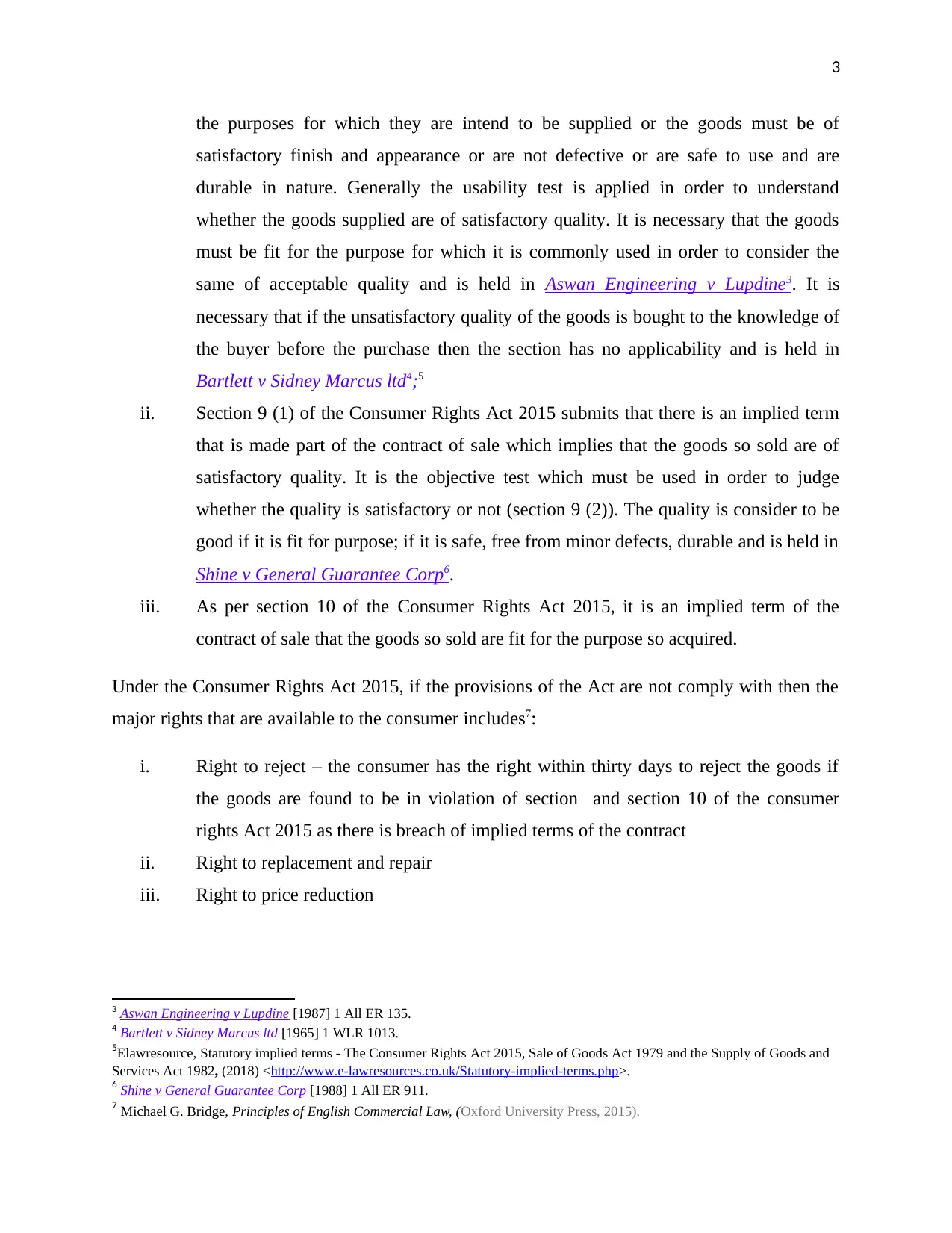
3
the purposes for which they are intend to be supplied or the goods must be of
satisfactory finish and appearance or are not defective or are safe to use and are
durable in nature. Generally the usability test is applied in order to understand
whether the goods supplied are of satisfactory quality. It is necessary that the goods
must be fit for the purpose for which it is commonly used in order to consider the
same of acceptable quality and is held in Aswan Engineering v Lupdine3. It is
necessary that if the unsatisfactory quality of the goods is bought to the knowledge of
the buyer before the purchase then the section has no applicability and is held in
Bartlett v Sidney Marcus ltd4;5
ii. Section 9 (1) of the Consumer Rights Act 2015 submits that there is an implied term
that is made part of the contract of sale which implies that the goods so sold are of
satisfactory quality. It is the objective test which must be used in order to judge
whether the quality is satisfactory or not (section 9 (2)). The quality is consider to be
good if it is fit for purpose; if it is safe, free from minor defects, durable and is held in
Shine v General Guarantee Corp6.
iii. As per section 10 of the Consumer Rights Act 2015, it is an implied term of the
contract of sale that the goods so sold are fit for the purpose so acquired.
Under the Consumer Rights Act 2015, if the provisions of the Act are not comply with then the
major rights that are available to the consumer includes7:
i. Right to reject – the consumer has the right within thirty days to reject the goods if
the goods are found to be in violation of section and section 10 of the consumer
rights Act 2015 as there is breach of implied terms of the contract
ii. Right to replacement and repair
iii. Right to price reduction
3 Aswan Engineering v Lupdine [1987] 1 All ER 135.
4 Bartlett v Sidney Marcus ltd [1965] 1 WLR 1013.
5Elawresource, Statutory implied terms - The Consumer Rights Act 2015, Sale of Goods Act 1979 and the Supply of Goods and
Services Act 1982, (2018) <http://www.e-lawresources.co.uk/Statutory-implied-terms.php>.
6 Shine v General Guarantee Corp [1988] 1 All ER 911.
7 Michael G. Bridge, Principles of English Commercial Law, (Oxford University Press, 2015).
the purposes for which they are intend to be supplied or the goods must be of
satisfactory finish and appearance or are not defective or are safe to use and are
durable in nature. Generally the usability test is applied in order to understand
whether the goods supplied are of satisfactory quality. It is necessary that the goods
must be fit for the purpose for which it is commonly used in order to consider the
same of acceptable quality and is held in Aswan Engineering v Lupdine3. It is
necessary that if the unsatisfactory quality of the goods is bought to the knowledge of
the buyer before the purchase then the section has no applicability and is held in
Bartlett v Sidney Marcus ltd4;5
ii. Section 9 (1) of the Consumer Rights Act 2015 submits that there is an implied term
that is made part of the contract of sale which implies that the goods so sold are of
satisfactory quality. It is the objective test which must be used in order to judge
whether the quality is satisfactory or not (section 9 (2)). The quality is consider to be
good if it is fit for purpose; if it is safe, free from minor defects, durable and is held in
Shine v General Guarantee Corp6.
iii. As per section 10 of the Consumer Rights Act 2015, it is an implied term of the
contract of sale that the goods so sold are fit for the purpose so acquired.
Under the Consumer Rights Act 2015, if the provisions of the Act are not comply with then the
major rights that are available to the consumer includes7:
i. Right to reject – the consumer has the right within thirty days to reject the goods if
the goods are found to be in violation of section and section 10 of the consumer
rights Act 2015 as there is breach of implied terms of the contract
ii. Right to replacement and repair
iii. Right to price reduction
3 Aswan Engineering v Lupdine [1987] 1 All ER 135.
4 Bartlett v Sidney Marcus ltd [1965] 1 WLR 1013.
5Elawresource, Statutory implied terms - The Consumer Rights Act 2015, Sale of Goods Act 1979 and the Supply of Goods and
Services Act 1982, (2018) <http://www.e-lawresources.co.uk/Statutory-implied-terms.php>.
6 Shine v General Guarantee Corp [1988] 1 All ER 911.
7 Michael G. Bridge, Principles of English Commercial Law, (Oxford University Press, 2015).
⊘ This is a preview!⊘
Do you want full access?
Subscribe today to unlock all pages.

Trusted by 1+ million students worldwide
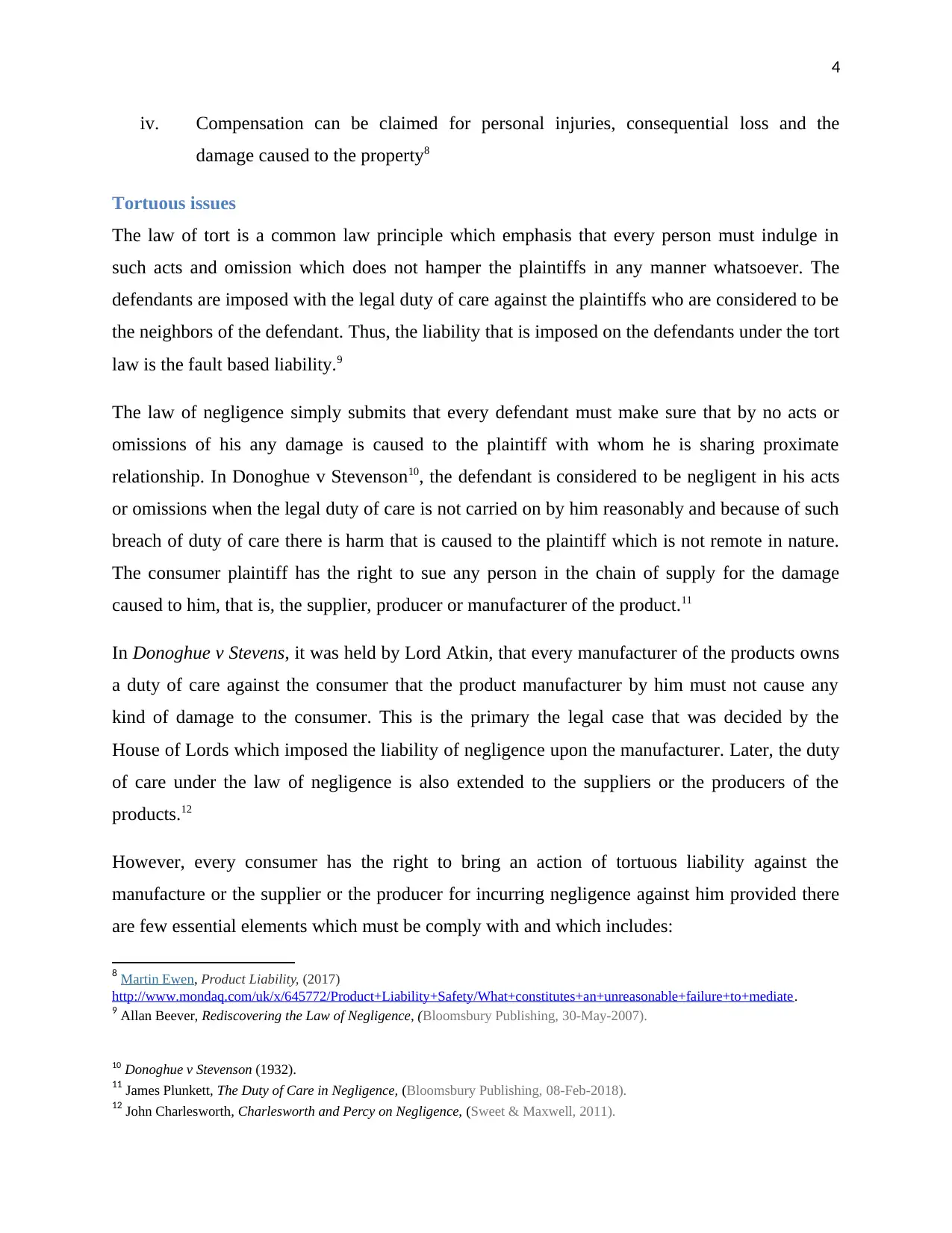
4
iv. Compensation can be claimed for personal injuries, consequential loss and the
damage caused to the property8
Tortuous issues
The law of tort is a common law principle which emphasis that every person must indulge in
such acts and omission which does not hamper the plaintiffs in any manner whatsoever. The
defendants are imposed with the legal duty of care against the plaintiffs who are considered to be
the neighbors of the defendant. Thus, the liability that is imposed on the defendants under the tort
law is the fault based liability.9
The law of negligence simply submits that every defendant must make sure that by no acts or
omissions of his any damage is caused to the plaintiff with whom he is sharing proximate
relationship. In Donoghue v Stevenson10, the defendant is considered to be negligent in his acts
or omissions when the legal duty of care is not carried on by him reasonably and because of such
breach of duty of care there is harm that is caused to the plaintiff which is not remote in nature.
The consumer plaintiff has the right to sue any person in the chain of supply for the damage
caused to him, that is, the supplier, producer or manufacturer of the product.11
In Donoghue v Stevens, it was held by Lord Atkin, that every manufacturer of the products owns
a duty of care against the consumer that the product manufacturer by him must not cause any
kind of damage to the consumer. This is the primary the legal case that was decided by the
House of Lords which imposed the liability of negligence upon the manufacturer. Later, the duty
of care under the law of negligence is also extended to the suppliers or the producers of the
products.12
However, every consumer has the right to bring an action of tortuous liability against the
manufacture or the supplier or the producer for incurring negligence against him provided there
are few essential elements which must be comply with and which includes:
8 Martin Ewen, Product Liability, (2017)
http://www.mondaq.com/uk/x/645772/Product+Liability+Safety/What+constitutes+an+unreasonable+failure+to+mediate.
9 Allan Beever, Rediscovering the Law of Negligence, (Bloomsbury Publishing, 30-May-2007).
10 Donoghue v Stevenson (1932).
11 James Plunkett, The Duty of Care in Negligence, (Bloomsbury Publishing, 08-Feb-2018).
12 John Charlesworth, Charlesworth and Percy on Negligence, (Sweet & Maxwell, 2011).
iv. Compensation can be claimed for personal injuries, consequential loss and the
damage caused to the property8
Tortuous issues
The law of tort is a common law principle which emphasis that every person must indulge in
such acts and omission which does not hamper the plaintiffs in any manner whatsoever. The
defendants are imposed with the legal duty of care against the plaintiffs who are considered to be
the neighbors of the defendant. Thus, the liability that is imposed on the defendants under the tort
law is the fault based liability.9
The law of negligence simply submits that every defendant must make sure that by no acts or
omissions of his any damage is caused to the plaintiff with whom he is sharing proximate
relationship. In Donoghue v Stevenson10, the defendant is considered to be negligent in his acts
or omissions when the legal duty of care is not carried on by him reasonably and because of such
breach of duty of care there is harm that is caused to the plaintiff which is not remote in nature.
The consumer plaintiff has the right to sue any person in the chain of supply for the damage
caused to him, that is, the supplier, producer or manufacturer of the product.11
In Donoghue v Stevens, it was held by Lord Atkin, that every manufacturer of the products owns
a duty of care against the consumer that the product manufacturer by him must not cause any
kind of damage to the consumer. This is the primary the legal case that was decided by the
House of Lords which imposed the liability of negligence upon the manufacturer. Later, the duty
of care under the law of negligence is also extended to the suppliers or the producers of the
products.12
However, every consumer has the right to bring an action of tortuous liability against the
manufacture or the supplier or the producer for incurring negligence against him provided there
are few essential elements which must be comply with and which includes:
8 Martin Ewen, Product Liability, (2017)
http://www.mondaq.com/uk/x/645772/Product+Liability+Safety/What+constitutes+an+unreasonable+failure+to+mediate.
9 Allan Beever, Rediscovering the Law of Negligence, (Bloomsbury Publishing, 30-May-2007).
10 Donoghue v Stevenson (1932).
11 James Plunkett, The Duty of Care in Negligence, (Bloomsbury Publishing, 08-Feb-2018).
12 John Charlesworth, Charlesworth and Percy on Negligence, (Sweet & Maxwell, 2011).
Paraphrase This Document
Need a fresh take? Get an instant paraphrase of this document with our AI Paraphraser
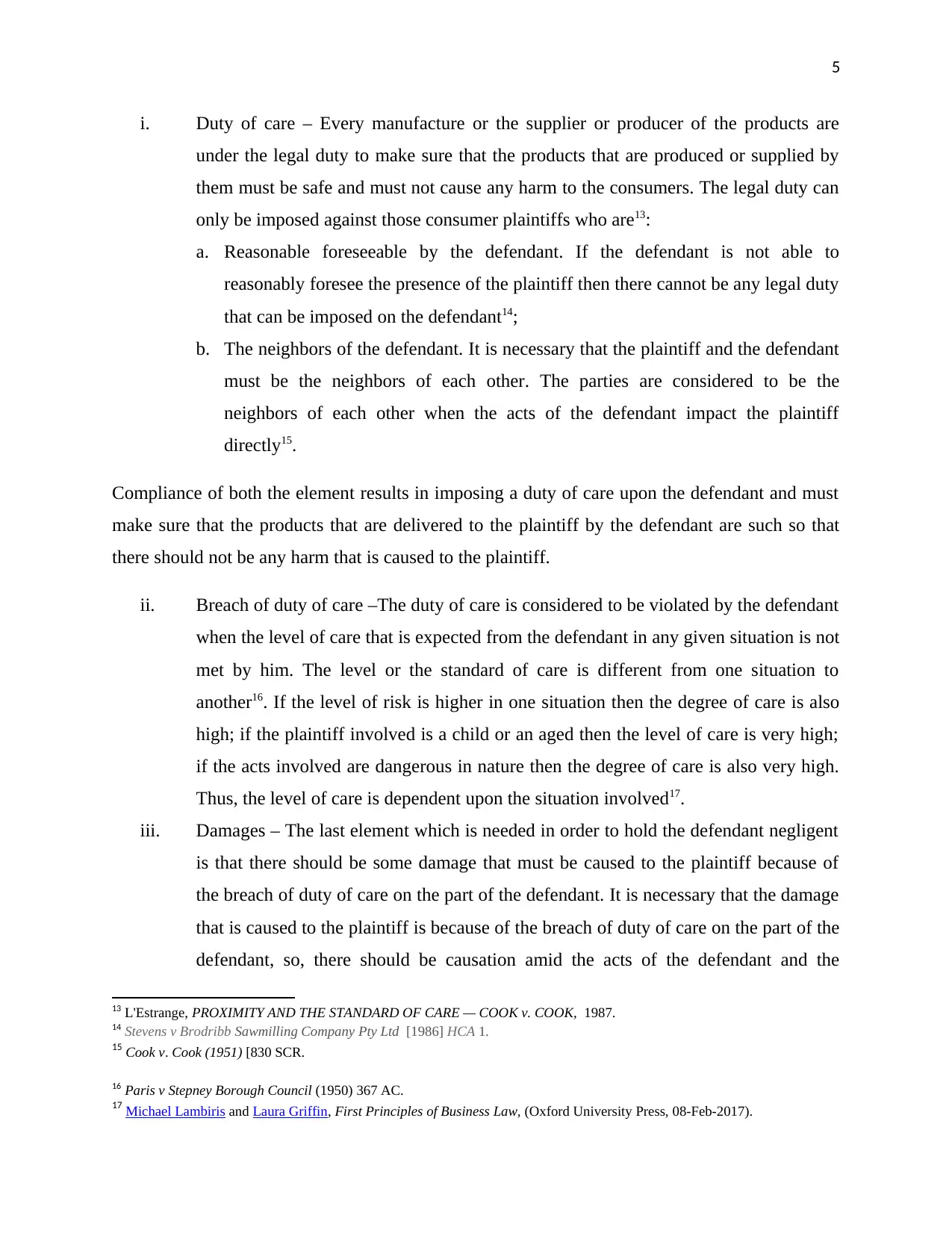
5
i. Duty of care – Every manufacture or the supplier or producer of the products are
under the legal duty to make sure that the products that are produced or supplied by
them must be safe and must not cause any harm to the consumers. The legal duty can
only be imposed against those consumer plaintiffs who are13:
a. Reasonable foreseeable by the defendant. If the defendant is not able to
reasonably foresee the presence of the plaintiff then there cannot be any legal duty
that can be imposed on the defendant14;
b. The neighbors of the defendant. It is necessary that the plaintiff and the defendant
must be the neighbors of each other. The parties are considered to be the
neighbors of each other when the acts of the defendant impact the plaintiff
directly15.
Compliance of both the element results in imposing a duty of care upon the defendant and must
make sure that the products that are delivered to the plaintiff by the defendant are such so that
there should not be any harm that is caused to the plaintiff.
ii. Breach of duty of care –The duty of care is considered to be violated by the defendant
when the level of care that is expected from the defendant in any given situation is not
met by him. The level or the standard of care is different from one situation to
another16. If the level of risk is higher in one situation then the degree of care is also
high; if the plaintiff involved is a child or an aged then the level of care is very high;
if the acts involved are dangerous in nature then the degree of care is also very high.
Thus, the level of care is dependent upon the situation involved17.
iii. Damages – The last element which is needed in order to hold the defendant negligent
is that there should be some damage that must be caused to the plaintiff because of
the breach of duty of care on the part of the defendant. It is necessary that the damage
that is caused to the plaintiff is because of the breach of duty of care on the part of the
defendant, so, there should be causation amid the acts of the defendant and the
13 L'Estrange, PROXIMITY AND THE STANDARD OF CARE — COOK v. COOK, 1987.
14 Stevens v Brodribb Sawmilling Company Pty Ltd [1986] HCA 1.
15 Cook v. Cook (1951) [830 SCR.
16 Paris v Stepney Borough Council (1950) 367 AC.
17 Michael Lambiris and Laura Griffin, First Principles of Business Law, (Oxford University Press, 08-Feb-2017).
i. Duty of care – Every manufacture or the supplier or producer of the products are
under the legal duty to make sure that the products that are produced or supplied by
them must be safe and must not cause any harm to the consumers. The legal duty can
only be imposed against those consumer plaintiffs who are13:
a. Reasonable foreseeable by the defendant. If the defendant is not able to
reasonably foresee the presence of the plaintiff then there cannot be any legal duty
that can be imposed on the defendant14;
b. The neighbors of the defendant. It is necessary that the plaintiff and the defendant
must be the neighbors of each other. The parties are considered to be the
neighbors of each other when the acts of the defendant impact the plaintiff
directly15.
Compliance of both the element results in imposing a duty of care upon the defendant and must
make sure that the products that are delivered to the plaintiff by the defendant are such so that
there should not be any harm that is caused to the plaintiff.
ii. Breach of duty of care –The duty of care is considered to be violated by the defendant
when the level of care that is expected from the defendant in any given situation is not
met by him. The level or the standard of care is different from one situation to
another16. If the level of risk is higher in one situation then the degree of care is also
high; if the plaintiff involved is a child or an aged then the level of care is very high;
if the acts involved are dangerous in nature then the degree of care is also very high.
Thus, the level of care is dependent upon the situation involved17.
iii. Damages – The last element which is needed in order to hold the defendant negligent
is that there should be some damage that must be caused to the plaintiff because of
the breach of duty of care on the part of the defendant. It is necessary that the damage
that is caused to the plaintiff is because of the breach of duty of care on the part of the
defendant, so, there should be causation amid the acts of the defendant and the
13 L'Estrange, PROXIMITY AND THE STANDARD OF CARE — COOK v. COOK, 1987.
14 Stevens v Brodribb Sawmilling Company Pty Ltd [1986] HCA 1.
15 Cook v. Cook (1951) [830 SCR.
16 Paris v Stepney Borough Council (1950) 367 AC.
17 Michael Lambiris and Laura Griffin, First Principles of Business Law, (Oxford University Press, 08-Feb-2017).
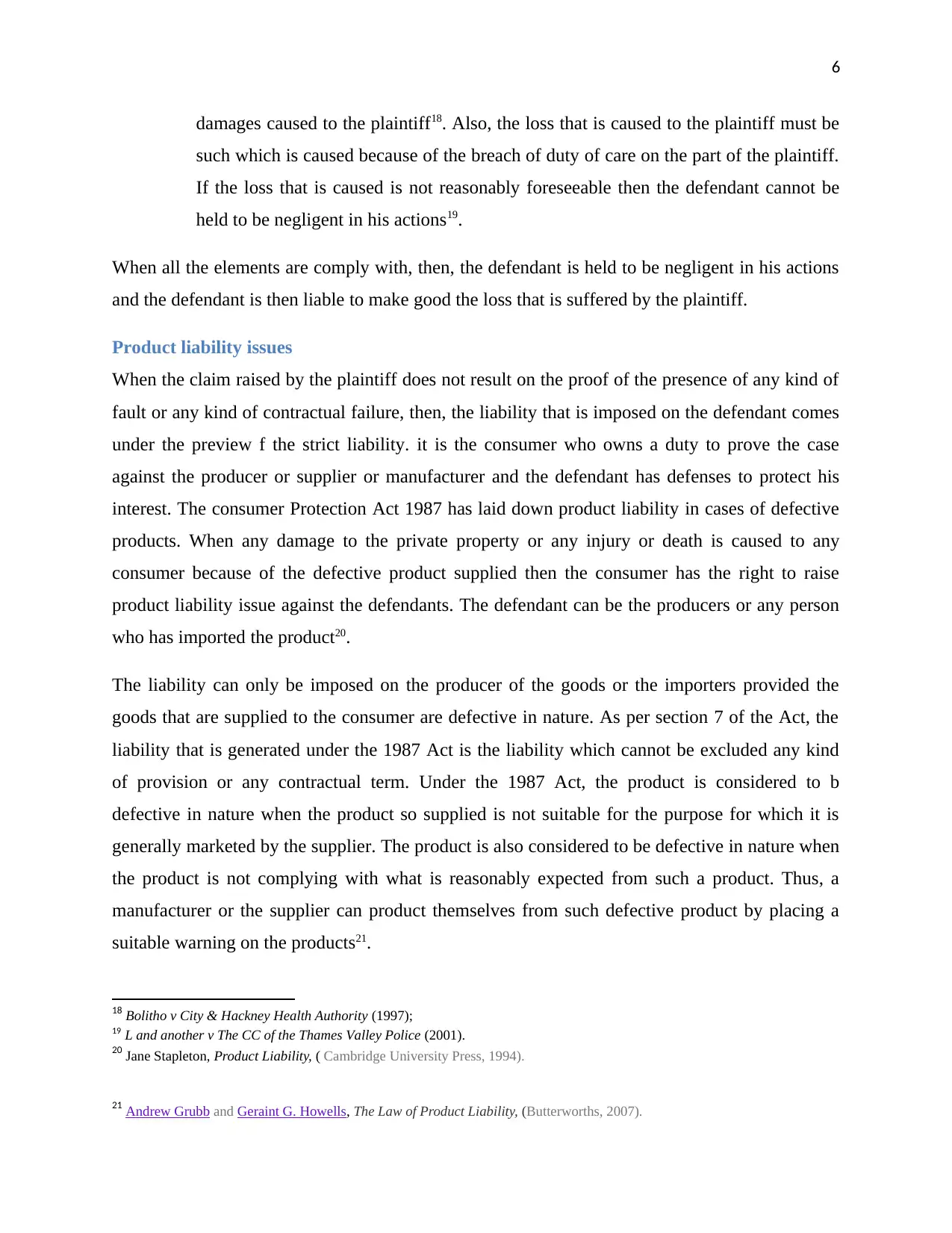
6
damages caused to the plaintiff18. Also, the loss that is caused to the plaintiff must be
such which is caused because of the breach of duty of care on the part of the plaintiff.
If the loss that is caused is not reasonably foreseeable then the defendant cannot be
held to be negligent in his actions19.
When all the elements are comply with, then, the defendant is held to be negligent in his actions
and the defendant is then liable to make good the loss that is suffered by the plaintiff.
Product liability issues
When the claim raised by the plaintiff does not result on the proof of the presence of any kind of
fault or any kind of contractual failure, then, the liability that is imposed on the defendant comes
under the preview f the strict liability. it is the consumer who owns a duty to prove the case
against the producer or supplier or manufacturer and the defendant has defenses to protect his
interest. The consumer Protection Act 1987 has laid down product liability in cases of defective
products. When any damage to the private property or any injury or death is caused to any
consumer because of the defective product supplied then the consumer has the right to raise
product liability issue against the defendants. The defendant can be the producers or any person
who has imported the product20.
The liability can only be imposed on the producer of the goods or the importers provided the
goods that are supplied to the consumer are defective in nature. As per section 7 of the Act, the
liability that is generated under the 1987 Act is the liability which cannot be excluded any kind
of provision or any contractual term. Under the 1987 Act, the product is considered to b
defective in nature when the product so supplied is not suitable for the purpose for which it is
generally marketed by the supplier. The product is also considered to be defective in nature when
the product is not complying with what is reasonably expected from such a product. Thus, a
manufacturer or the supplier can product themselves from such defective product by placing a
suitable warning on the products21.
18 Bolitho v City & Hackney Health Authority (1997);
19 L and another v The CC of the Thames Valley Police (2001).
20 Jane Stapleton, Product Liability, ( Cambridge University Press, 1994).
21 Andrew Grubb and Geraint G. Howells, The Law of Product Liability, (Butterworths, 2007).
damages caused to the plaintiff18. Also, the loss that is caused to the plaintiff must be
such which is caused because of the breach of duty of care on the part of the plaintiff.
If the loss that is caused is not reasonably foreseeable then the defendant cannot be
held to be negligent in his actions19.
When all the elements are comply with, then, the defendant is held to be negligent in his actions
and the defendant is then liable to make good the loss that is suffered by the plaintiff.
Product liability issues
When the claim raised by the plaintiff does not result on the proof of the presence of any kind of
fault or any kind of contractual failure, then, the liability that is imposed on the defendant comes
under the preview f the strict liability. it is the consumer who owns a duty to prove the case
against the producer or supplier or manufacturer and the defendant has defenses to protect his
interest. The consumer Protection Act 1987 has laid down product liability in cases of defective
products. When any damage to the private property or any injury or death is caused to any
consumer because of the defective product supplied then the consumer has the right to raise
product liability issue against the defendants. The defendant can be the producers or any person
who has imported the product20.
The liability can only be imposed on the producer of the goods or the importers provided the
goods that are supplied to the consumer are defective in nature. As per section 7 of the Act, the
liability that is generated under the 1987 Act is the liability which cannot be excluded any kind
of provision or any contractual term. Under the 1987 Act, the product is considered to b
defective in nature when the product so supplied is not suitable for the purpose for which it is
generally marketed by the supplier. The product is also considered to be defective in nature when
the product is not complying with what is reasonably expected from such a product. Thus, a
manufacturer or the supplier can product themselves from such defective product by placing a
suitable warning on the products21.
18 Bolitho v City & Hackney Health Authority (1997);
19 L and another v The CC of the Thames Valley Police (2001).
20 Jane Stapleton, Product Liability, ( Cambridge University Press, 1994).
21 Andrew Grubb and Geraint G. Howells, The Law of Product Liability, (Butterworths, 2007).
⊘ This is a preview!⊘
Do you want full access?
Subscribe today to unlock all pages.

Trusted by 1+ million students worldwide
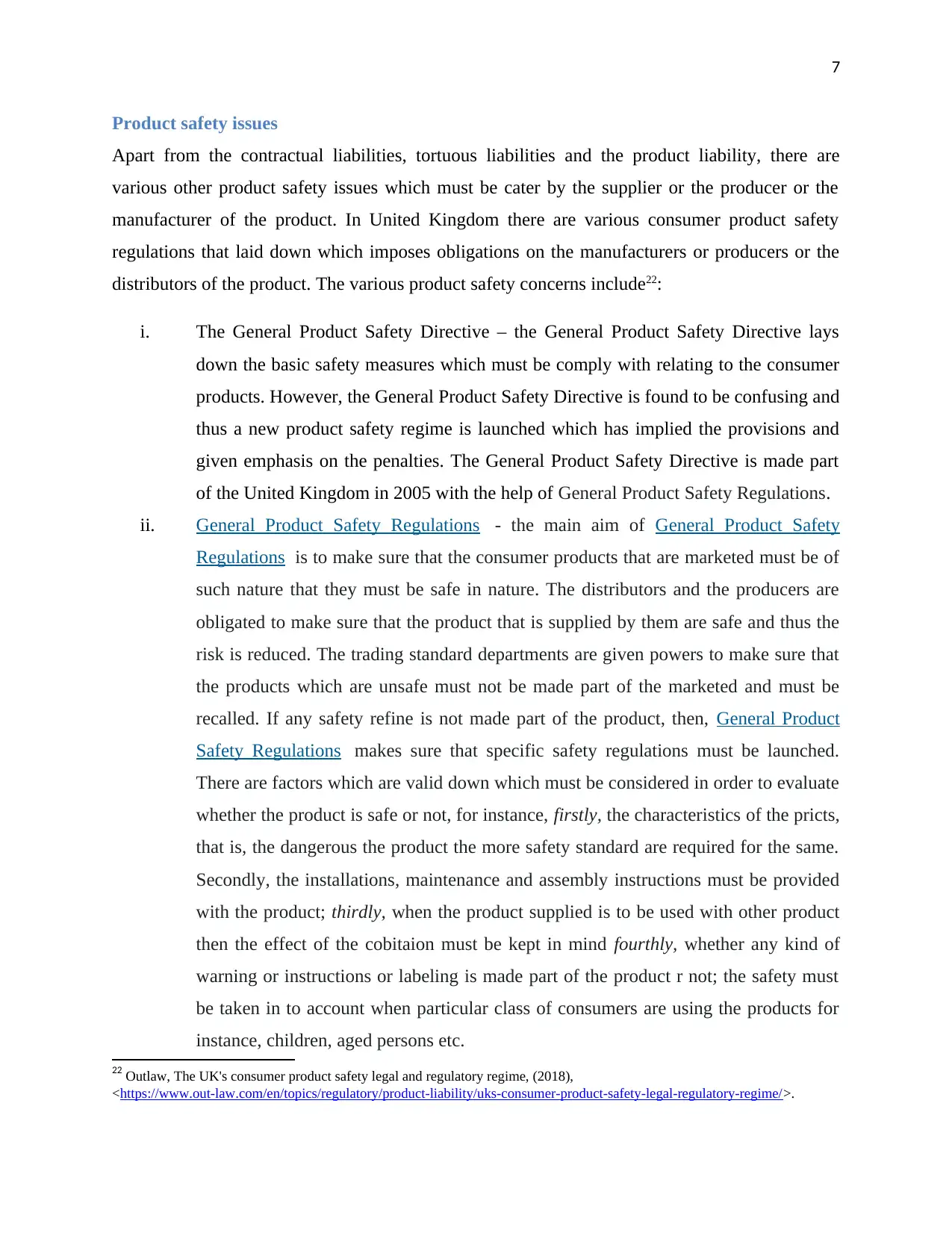
7
Product safety issues
Apart from the contractual liabilities, tortuous liabilities and the product liability, there are
various other product safety issues which must be cater by the supplier or the producer or the
manufacturer of the product. In United Kingdom there are various consumer product safety
regulations that laid down which imposes obligations on the manufacturers or producers or the
distributors of the product. The various product safety concerns include22:
i. The General Product Safety Directive – the General Product Safety Directive lays
down the basic safety measures which must be comply with relating to the consumer
products. However, the General Product Safety Directive is found to be confusing and
thus a new product safety regime is launched which has implied the provisions and
given emphasis on the penalties. The General Product Safety Directive is made part
of the United Kingdom in 2005 with the help of General Product Safety Regulations.
ii. General Product Safety Regulations - the main aim of General Product Safety
Regulations is to make sure that the consumer products that are marketed must be of
such nature that they must be safe in nature. The distributors and the producers are
obligated to make sure that the product that is supplied by them are safe and thus the
risk is reduced. The trading standard departments are given powers to make sure that
the products which are unsafe must not be made part of the marketed and must be
recalled. If any safety refine is not made part of the product, then, General Product
Safety Regulations makes sure that specific safety regulations must be launched.
There are factors which are valid down which must be considered in order to evaluate
whether the product is safe or not, for instance, firstly, the characteristics of the pricts,
that is, the dangerous the product the more safety standard are required for the same.
Secondly, the installations, maintenance and assembly instructions must be provided
with the product; thirdly, when the product supplied is to be used with other product
then the effect of the cobitaion must be kept in mind fourthly, whether any kind of
warning or instructions or labeling is made part of the product r not; the safety must
be taken in to account when particular class of consumers are using the products for
instance, children, aged persons etc.
22 Outlaw, The UK's consumer product safety legal and regulatory regime, (2018),
<https://www.out-law.com/en/topics/regulatory/product-liability/uks-consumer-product-safety-legal-regulatory-regime/>.
Product safety issues
Apart from the contractual liabilities, tortuous liabilities and the product liability, there are
various other product safety issues which must be cater by the supplier or the producer or the
manufacturer of the product. In United Kingdom there are various consumer product safety
regulations that laid down which imposes obligations on the manufacturers or producers or the
distributors of the product. The various product safety concerns include22:
i. The General Product Safety Directive – the General Product Safety Directive lays
down the basic safety measures which must be comply with relating to the consumer
products. However, the General Product Safety Directive is found to be confusing and
thus a new product safety regime is launched which has implied the provisions and
given emphasis on the penalties. The General Product Safety Directive is made part
of the United Kingdom in 2005 with the help of General Product Safety Regulations.
ii. General Product Safety Regulations - the main aim of General Product Safety
Regulations is to make sure that the consumer products that are marketed must be of
such nature that they must be safe in nature. The distributors and the producers are
obligated to make sure that the product that is supplied by them are safe and thus the
risk is reduced. The trading standard departments are given powers to make sure that
the products which are unsafe must not be made part of the marketed and must be
recalled. If any safety refine is not made part of the product, then, General Product
Safety Regulations makes sure that specific safety regulations must be launched.
There are factors which are valid down which must be considered in order to evaluate
whether the product is safe or not, for instance, firstly, the characteristics of the pricts,
that is, the dangerous the product the more safety standard are required for the same.
Secondly, the installations, maintenance and assembly instructions must be provided
with the product; thirdly, when the product supplied is to be used with other product
then the effect of the cobitaion must be kept in mind fourthly, whether any kind of
warning or instructions or labeling is made part of the product r not; the safety must
be taken in to account when particular class of consumers are using the products for
instance, children, aged persons etc.
22 Outlaw, The UK's consumer product safety legal and regulatory regime, (2018),
<https://www.out-law.com/en/topics/regulatory/product-liability/uks-consumer-product-safety-legal-regulatory-regime/>.
Paraphrase This Document
Need a fresh take? Get an instant paraphrase of this document with our AI Paraphraser
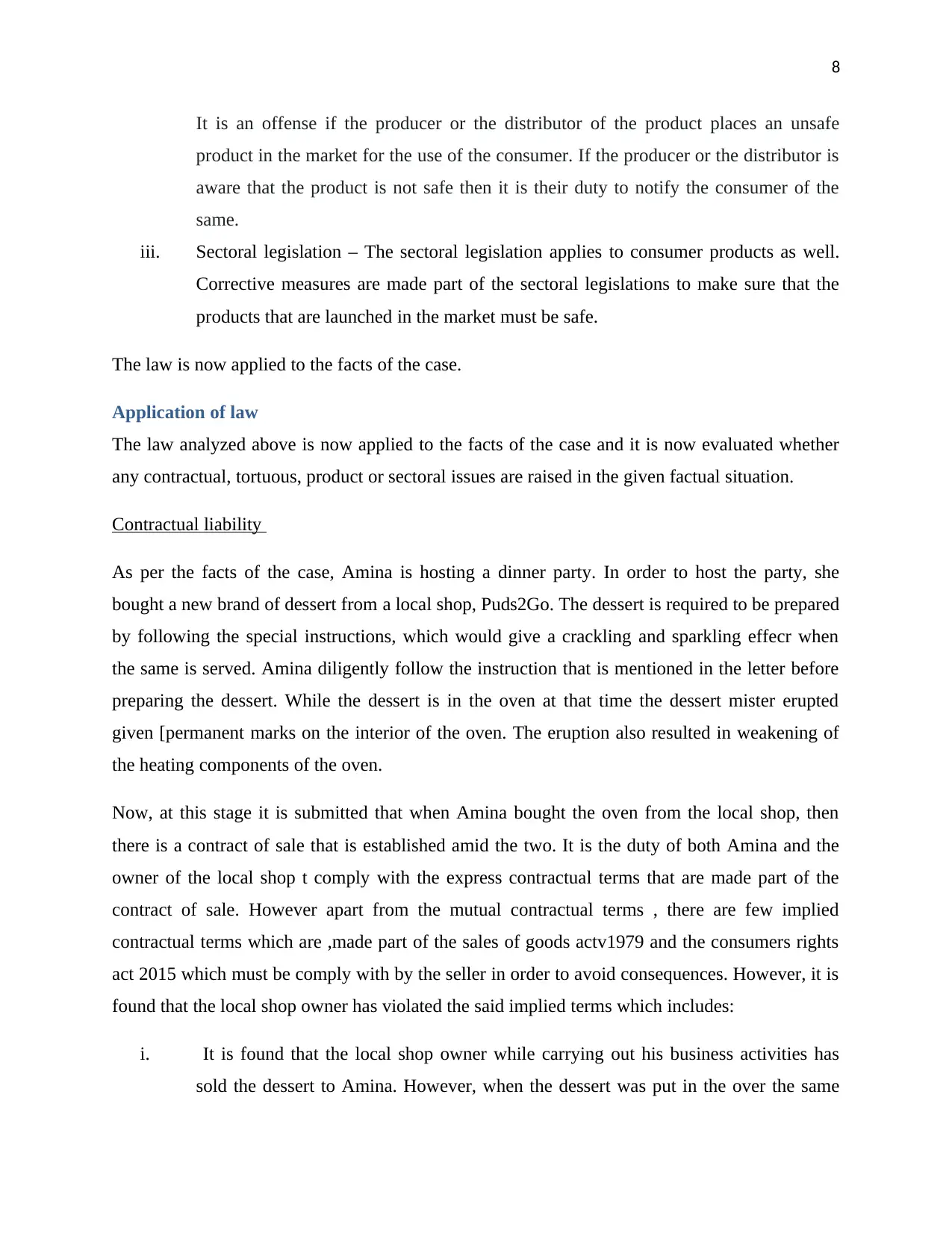
8
It is an offense if the producer or the distributor of the product places an unsafe
product in the market for the use of the consumer. If the producer or the distributor is
aware that the product is not safe then it is their duty to notify the consumer of the
same.
iii. Sectoral legislation – The sectoral legislation applies to consumer products as well.
Corrective measures are made part of the sectoral legislations to make sure that the
products that are launched in the market must be safe.
The law is now applied to the facts of the case.
Application of law
The law analyzed above is now applied to the facts of the case and it is now evaluated whether
any contractual, tortuous, product or sectoral issues are raised in the given factual situation.
Contractual liability
As per the facts of the case, Amina is hosting a dinner party. In order to host the party, she
bought a new brand of dessert from a local shop, Puds2Go. The dessert is required to be prepared
by following the special instructions, which would give a crackling and sparkling effecr when
the same is served. Amina diligently follow the instruction that is mentioned in the letter before
preparing the dessert. While the dessert is in the oven at that time the dessert mister erupted
given [permanent marks on the interior of the oven. The eruption also resulted in weakening of
the heating components of the oven.
Now, at this stage it is submitted that when Amina bought the oven from the local shop, then
there is a contract of sale that is established amid the two. It is the duty of both Amina and the
owner of the local shop t comply with the express contractual terms that are made part of the
contract of sale. However apart from the mutual contractual terms , there are few implied
contractual terms which are ,made part of the sales of goods actv1979 and the consumers rights
act 2015 which must be comply with by the seller in order to avoid consequences. However, it is
found that the local shop owner has violated the said implied terms which includes:
i. It is found that the local shop owner while carrying out his business activities has
sold the dessert to Amina. However, when the dessert was put in the over the same
It is an offense if the producer or the distributor of the product places an unsafe
product in the market for the use of the consumer. If the producer or the distributor is
aware that the product is not safe then it is their duty to notify the consumer of the
same.
iii. Sectoral legislation – The sectoral legislation applies to consumer products as well.
Corrective measures are made part of the sectoral legislations to make sure that the
products that are launched in the market must be safe.
The law is now applied to the facts of the case.
Application of law
The law analyzed above is now applied to the facts of the case and it is now evaluated whether
any contractual, tortuous, product or sectoral issues are raised in the given factual situation.
Contractual liability
As per the facts of the case, Amina is hosting a dinner party. In order to host the party, she
bought a new brand of dessert from a local shop, Puds2Go. The dessert is required to be prepared
by following the special instructions, which would give a crackling and sparkling effecr when
the same is served. Amina diligently follow the instruction that is mentioned in the letter before
preparing the dessert. While the dessert is in the oven at that time the dessert mister erupted
given [permanent marks on the interior of the oven. The eruption also resulted in weakening of
the heating components of the oven.
Now, at this stage it is submitted that when Amina bought the oven from the local shop, then
there is a contract of sale that is established amid the two. It is the duty of both Amina and the
owner of the local shop t comply with the express contractual terms that are made part of the
contract of sale. However apart from the mutual contractual terms , there are few implied
contractual terms which are ,made part of the sales of goods actv1979 and the consumers rights
act 2015 which must be comply with by the seller in order to avoid consequences. However, it is
found that the local shop owner has violated the said implied terms which includes:
i. It is found that the local shop owner while carrying out his business activities has
sold the dessert to Amina. However, when the dessert was put in the over the same
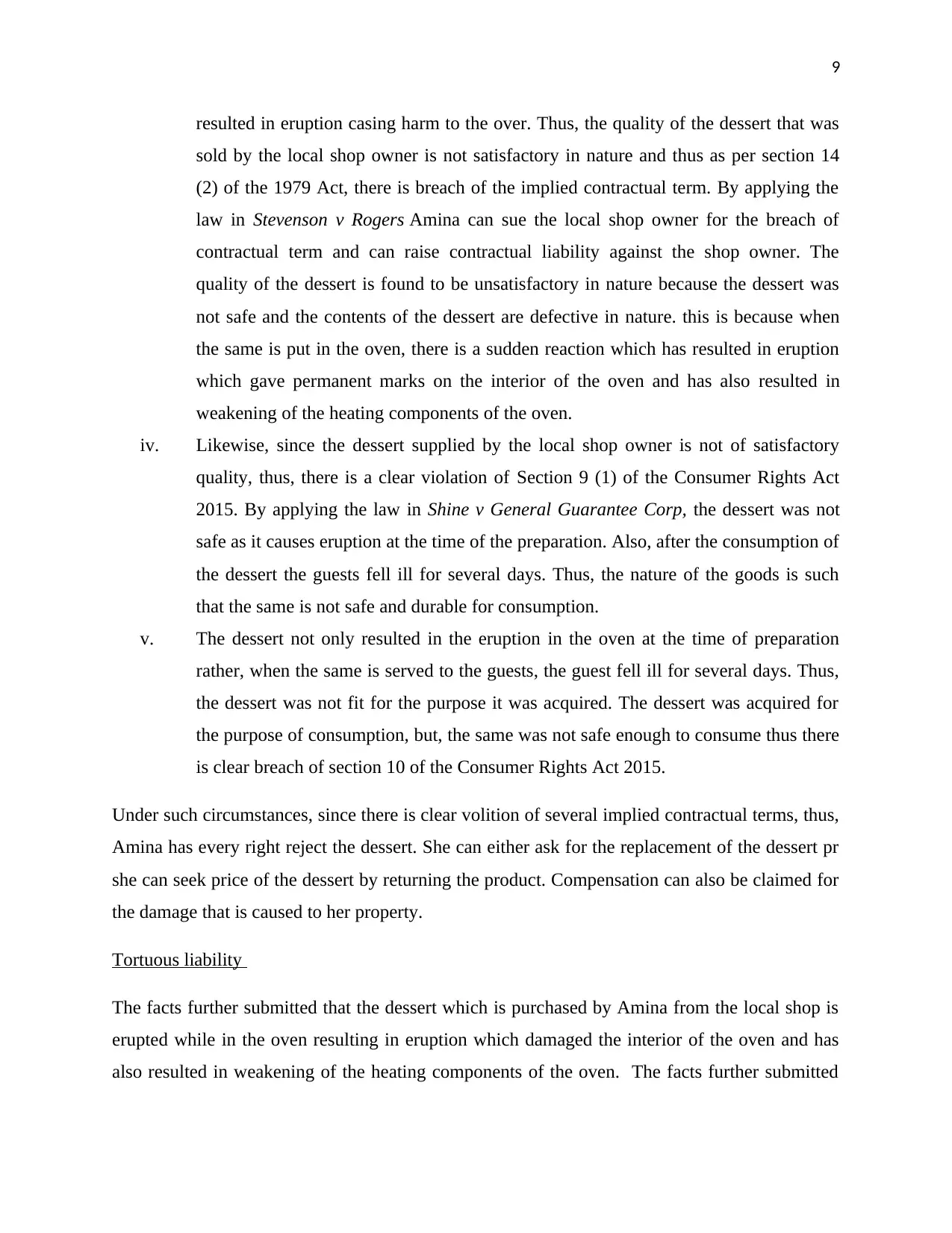
9
resulted in eruption casing harm to the over. Thus, the quality of the dessert that was
sold by the local shop owner is not satisfactory in nature and thus as per section 14
(2) of the 1979 Act, there is breach of the implied contractual term. By applying the
law in Stevenson v Rogers Amina can sue the local shop owner for the breach of
contractual term and can raise contractual liability against the shop owner. The
quality of the dessert is found to be unsatisfactory in nature because the dessert was
not safe and the contents of the dessert are defective in nature. this is because when
the same is put in the oven, there is a sudden reaction which has resulted in eruption
which gave permanent marks on the interior of the oven and has also resulted in
weakening of the heating components of the oven.
iv. Likewise, since the dessert supplied by the local shop owner is not of satisfactory
quality, thus, there is a clear violation of Section 9 (1) of the Consumer Rights Act
2015. By applying the law in Shine v General Guarantee Corp, the dessert was not
safe as it causes eruption at the time of the preparation. Also, after the consumption of
the dessert the guests fell ill for several days. Thus, the nature of the goods is such
that the same is not safe and durable for consumption.
v. The dessert not only resulted in the eruption in the oven at the time of preparation
rather, when the same is served to the guests, the guest fell ill for several days. Thus,
the dessert was not fit for the purpose it was acquired. The dessert was acquired for
the purpose of consumption, but, the same was not safe enough to consume thus there
is clear breach of section 10 of the Consumer Rights Act 2015.
Under such circumstances, since there is clear volition of several implied contractual terms, thus,
Amina has every right reject the dessert. She can either ask for the replacement of the dessert pr
she can seek price of the dessert by returning the product. Compensation can also be claimed for
the damage that is caused to her property.
Tortuous liability
The facts further submitted that the dessert which is purchased by Amina from the local shop is
erupted while in the oven resulting in eruption which damaged the interior of the oven and has
also resulted in weakening of the heating components of the oven. The facts further submitted
resulted in eruption casing harm to the over. Thus, the quality of the dessert that was
sold by the local shop owner is not satisfactory in nature and thus as per section 14
(2) of the 1979 Act, there is breach of the implied contractual term. By applying the
law in Stevenson v Rogers Amina can sue the local shop owner for the breach of
contractual term and can raise contractual liability against the shop owner. The
quality of the dessert is found to be unsatisfactory in nature because the dessert was
not safe and the contents of the dessert are defective in nature. this is because when
the same is put in the oven, there is a sudden reaction which has resulted in eruption
which gave permanent marks on the interior of the oven and has also resulted in
weakening of the heating components of the oven.
iv. Likewise, since the dessert supplied by the local shop owner is not of satisfactory
quality, thus, there is a clear violation of Section 9 (1) of the Consumer Rights Act
2015. By applying the law in Shine v General Guarantee Corp, the dessert was not
safe as it causes eruption at the time of the preparation. Also, after the consumption of
the dessert the guests fell ill for several days. Thus, the nature of the goods is such
that the same is not safe and durable for consumption.
v. The dessert not only resulted in the eruption in the oven at the time of preparation
rather, when the same is served to the guests, the guest fell ill for several days. Thus,
the dessert was not fit for the purpose it was acquired. The dessert was acquired for
the purpose of consumption, but, the same was not safe enough to consume thus there
is clear breach of section 10 of the Consumer Rights Act 2015.
Under such circumstances, since there is clear volition of several implied contractual terms, thus,
Amina has every right reject the dessert. She can either ask for the replacement of the dessert pr
she can seek price of the dessert by returning the product. Compensation can also be claimed for
the damage that is caused to her property.
Tortuous liability
The facts further submitted that the dessert which is purchased by Amina from the local shop is
erupted while in the oven resulting in eruption which damaged the interior of the oven and has
also resulted in weakening of the heating components of the oven. The facts further submitted
⊘ This is a preview!⊘
Do you want full access?
Subscribe today to unlock all pages.

Trusted by 1+ million students worldwide
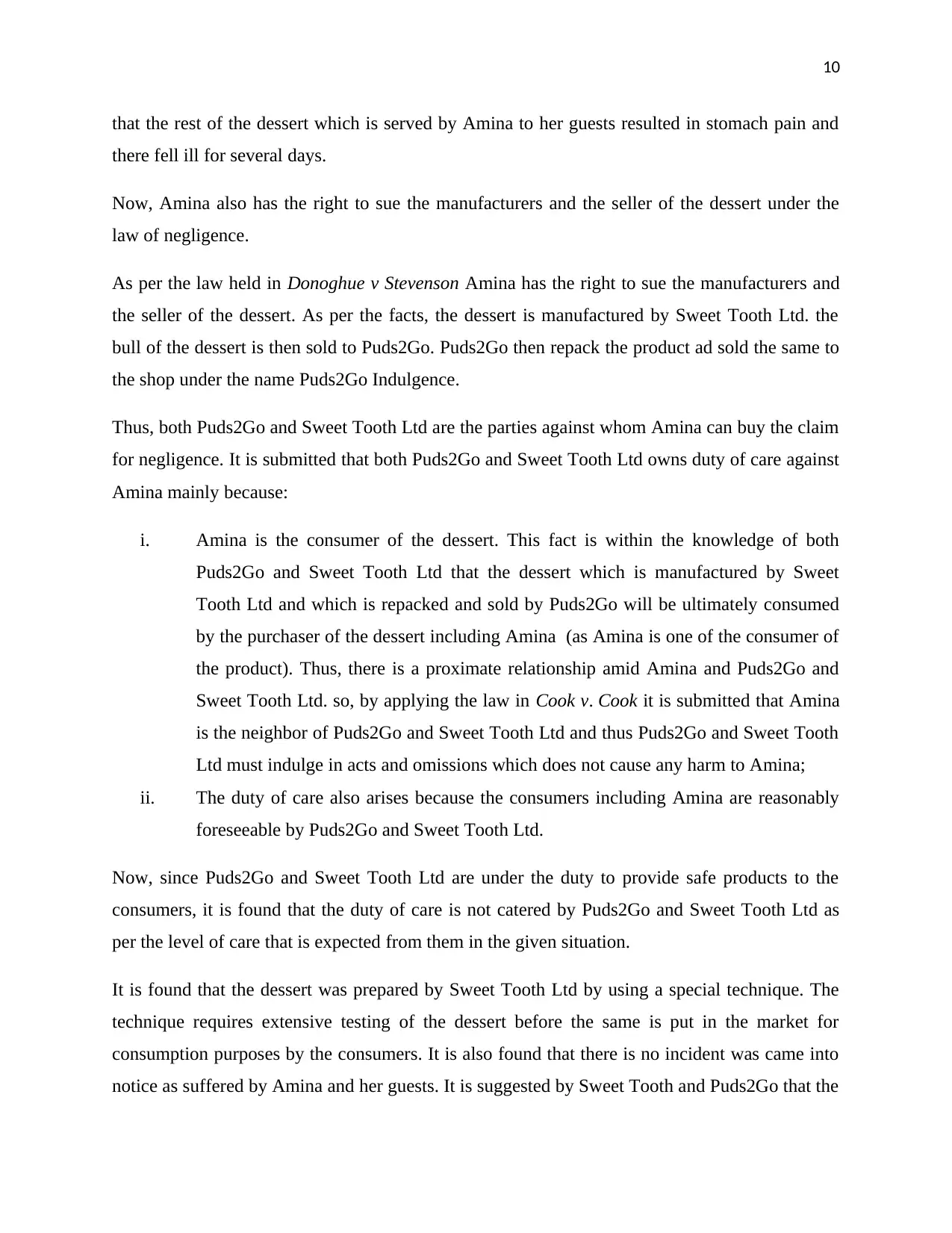
10
that the rest of the dessert which is served by Amina to her guests resulted in stomach pain and
there fell ill for several days.
Now, Amina also has the right to sue the manufacturers and the seller of the dessert under the
law of negligence.
As per the law held in Donoghue v Stevenson Amina has the right to sue the manufacturers and
the seller of the dessert. As per the facts, the dessert is manufactured by Sweet Tooth Ltd. the
bull of the dessert is then sold to Puds2Go. Puds2Go then repack the product ad sold the same to
the shop under the name Puds2Go Indulgence.
Thus, both Puds2Go and Sweet Tooth Ltd are the parties against whom Amina can buy the claim
for negligence. It is submitted that both Puds2Go and Sweet Tooth Ltd owns duty of care against
Amina mainly because:
i. Amina is the consumer of the dessert. This fact is within the knowledge of both
Puds2Go and Sweet Tooth Ltd that the dessert which is manufactured by Sweet
Tooth Ltd and which is repacked and sold by Puds2Go will be ultimately consumed
by the purchaser of the dessert including Amina (as Amina is one of the consumer of
the product). Thus, there is a proximate relationship amid Amina and Puds2Go and
Sweet Tooth Ltd. so, by applying the law in Cook v. Cook it is submitted that Amina
is the neighbor of Puds2Go and Sweet Tooth Ltd and thus Puds2Go and Sweet Tooth
Ltd must indulge in acts and omissions which does not cause any harm to Amina;
ii. The duty of care also arises because the consumers including Amina are reasonably
foreseeable by Puds2Go and Sweet Tooth Ltd.
Now, since Puds2Go and Sweet Tooth Ltd are under the duty to provide safe products to the
consumers, it is found that the duty of care is not catered by Puds2Go and Sweet Tooth Ltd as
per the level of care that is expected from them in the given situation.
It is found that the dessert was prepared by Sweet Tooth Ltd by using a special technique. The
technique requires extensive testing of the dessert before the same is put in the market for
consumption purposes by the consumers. It is also found that there is no incident was came into
notice as suffered by Amina and her guests. It is suggested by Sweet Tooth and Puds2Go that the
that the rest of the dessert which is served by Amina to her guests resulted in stomach pain and
there fell ill for several days.
Now, Amina also has the right to sue the manufacturers and the seller of the dessert under the
law of negligence.
As per the law held in Donoghue v Stevenson Amina has the right to sue the manufacturers and
the seller of the dessert. As per the facts, the dessert is manufactured by Sweet Tooth Ltd. the
bull of the dessert is then sold to Puds2Go. Puds2Go then repack the product ad sold the same to
the shop under the name Puds2Go Indulgence.
Thus, both Puds2Go and Sweet Tooth Ltd are the parties against whom Amina can buy the claim
for negligence. It is submitted that both Puds2Go and Sweet Tooth Ltd owns duty of care against
Amina mainly because:
i. Amina is the consumer of the dessert. This fact is within the knowledge of both
Puds2Go and Sweet Tooth Ltd that the dessert which is manufactured by Sweet
Tooth Ltd and which is repacked and sold by Puds2Go will be ultimately consumed
by the purchaser of the dessert including Amina (as Amina is one of the consumer of
the product). Thus, there is a proximate relationship amid Amina and Puds2Go and
Sweet Tooth Ltd. so, by applying the law in Cook v. Cook it is submitted that Amina
is the neighbor of Puds2Go and Sweet Tooth Ltd and thus Puds2Go and Sweet Tooth
Ltd must indulge in acts and omissions which does not cause any harm to Amina;
ii. The duty of care also arises because the consumers including Amina are reasonably
foreseeable by Puds2Go and Sweet Tooth Ltd.
Now, since Puds2Go and Sweet Tooth Ltd are under the duty to provide safe products to the
consumers, it is found that the duty of care is not catered by Puds2Go and Sweet Tooth Ltd as
per the level of care that is expected from them in the given situation.
It is found that the dessert was prepared by Sweet Tooth Ltd by using a special technique. The
technique requires extensive testing of the dessert before the same is put in the market for
consumption purposes by the consumers. It is also found that there is no incident was came into
notice as suffered by Amina and her guests. It is suggested by Sweet Tooth and Puds2Go that the
Paraphrase This Document
Need a fresh take? Get an instant paraphrase of this document with our AI Paraphraser
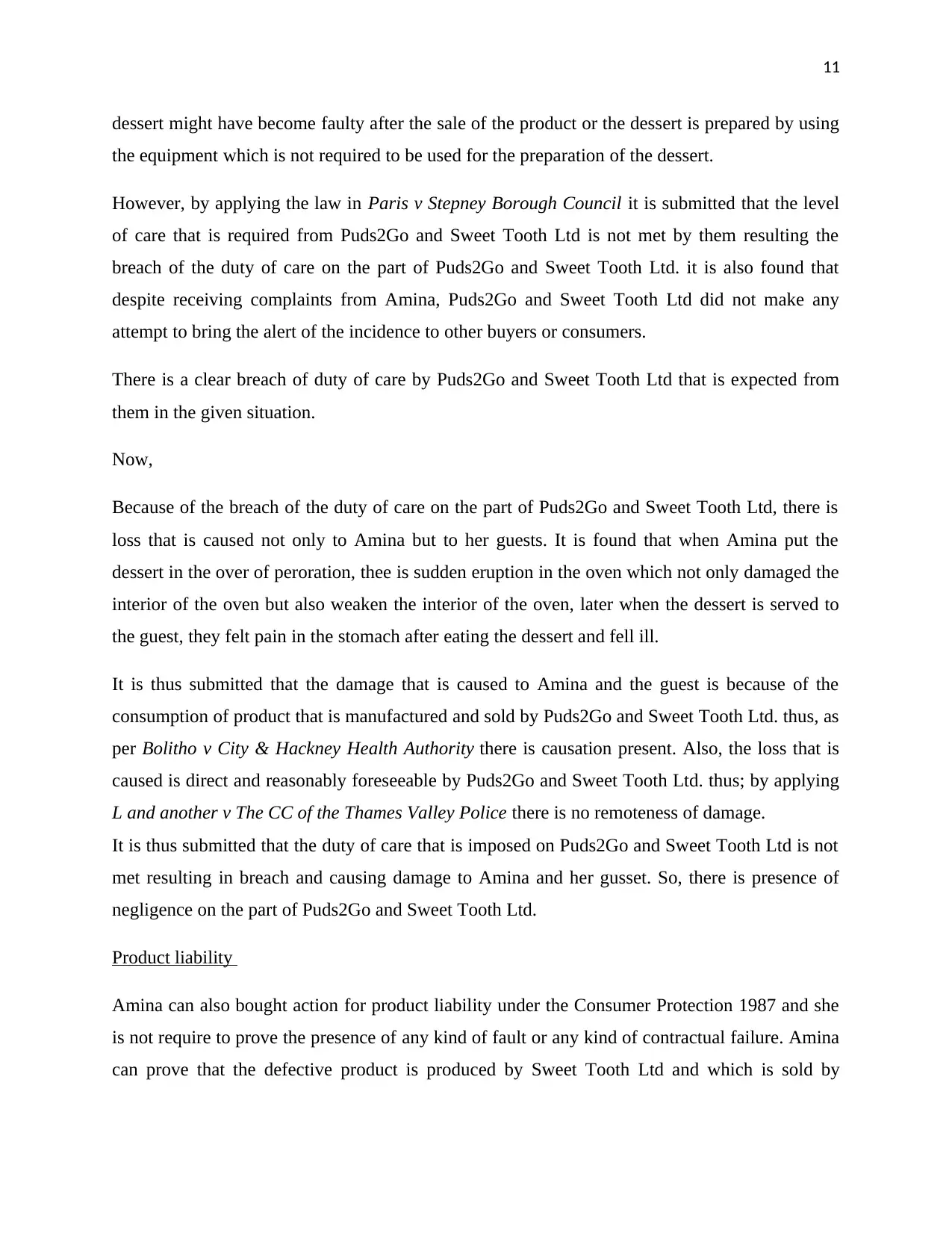
11
dessert might have become faulty after the sale of the product or the dessert is prepared by using
the equipment which is not required to be used for the preparation of the dessert.
However, by applying the law in Paris v Stepney Borough Council it is submitted that the level
of care that is required from Puds2Go and Sweet Tooth Ltd is not met by them resulting the
breach of the duty of care on the part of Puds2Go and Sweet Tooth Ltd. it is also found that
despite receiving complaints from Amina, Puds2Go and Sweet Tooth Ltd did not make any
attempt to bring the alert of the incidence to other buyers or consumers.
There is a clear breach of duty of care by Puds2Go and Sweet Tooth Ltd that is expected from
them in the given situation.
Now,
Because of the breach of the duty of care on the part of Puds2Go and Sweet Tooth Ltd, there is
loss that is caused not only to Amina but to her guests. It is found that when Amina put the
dessert in the over of peroration, thee is sudden eruption in the oven which not only damaged the
interior of the oven but also weaken the interior of the oven, later when the dessert is served to
the guest, they felt pain in the stomach after eating the dessert and fell ill.
It is thus submitted that the damage that is caused to Amina and the guest is because of the
consumption of product that is manufactured and sold by Puds2Go and Sweet Tooth Ltd. thus, as
per Bolitho v City & Hackney Health Authority there is causation present. Also, the loss that is
caused is direct and reasonably foreseeable by Puds2Go and Sweet Tooth Ltd. thus; by applying
L and another v The CC of the Thames Valley Police there is no remoteness of damage.
It is thus submitted that the duty of care that is imposed on Puds2Go and Sweet Tooth Ltd is not
met resulting in breach and causing damage to Amina and her gusset. So, there is presence of
negligence on the part of Puds2Go and Sweet Tooth Ltd.
Product liability
Amina can also bought action for product liability under the Consumer Protection 1987 and she
is not require to prove the presence of any kind of fault or any kind of contractual failure. Amina
can prove that the defective product is produced by Sweet Tooth Ltd and which is sold by
dessert might have become faulty after the sale of the product or the dessert is prepared by using
the equipment which is not required to be used for the preparation of the dessert.
However, by applying the law in Paris v Stepney Borough Council it is submitted that the level
of care that is required from Puds2Go and Sweet Tooth Ltd is not met by them resulting the
breach of the duty of care on the part of Puds2Go and Sweet Tooth Ltd. it is also found that
despite receiving complaints from Amina, Puds2Go and Sweet Tooth Ltd did not make any
attempt to bring the alert of the incidence to other buyers or consumers.
There is a clear breach of duty of care by Puds2Go and Sweet Tooth Ltd that is expected from
them in the given situation.
Now,
Because of the breach of the duty of care on the part of Puds2Go and Sweet Tooth Ltd, there is
loss that is caused not only to Amina but to her guests. It is found that when Amina put the
dessert in the over of peroration, thee is sudden eruption in the oven which not only damaged the
interior of the oven but also weaken the interior of the oven, later when the dessert is served to
the guest, they felt pain in the stomach after eating the dessert and fell ill.
It is thus submitted that the damage that is caused to Amina and the guest is because of the
consumption of product that is manufactured and sold by Puds2Go and Sweet Tooth Ltd. thus, as
per Bolitho v City & Hackney Health Authority there is causation present. Also, the loss that is
caused is direct and reasonably foreseeable by Puds2Go and Sweet Tooth Ltd. thus; by applying
L and another v The CC of the Thames Valley Police there is no remoteness of damage.
It is thus submitted that the duty of care that is imposed on Puds2Go and Sweet Tooth Ltd is not
met resulting in breach and causing damage to Amina and her gusset. So, there is presence of
negligence on the part of Puds2Go and Sweet Tooth Ltd.
Product liability
Amina can also bought action for product liability under the Consumer Protection 1987 and she
is not require to prove the presence of any kind of fault or any kind of contractual failure. Amina
can prove that the defective product is produced by Sweet Tooth Ltd and which is sold by
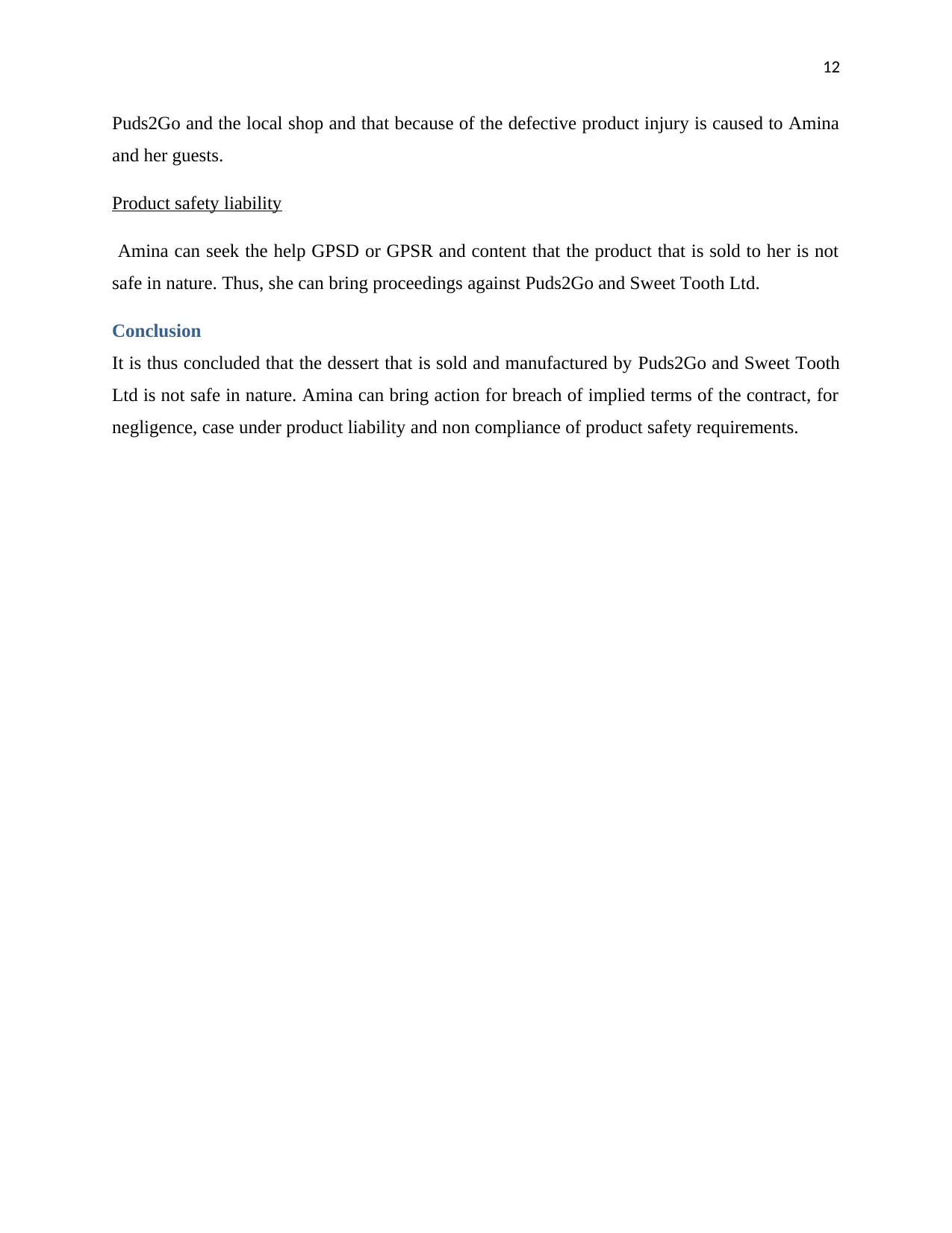
12
Puds2Go and the local shop and that because of the defective product injury is caused to Amina
and her guests.
Product safety liability
Amina can seek the help GPSD or GPSR and content that the product that is sold to her is not
safe in nature. Thus, she can bring proceedings against Puds2Go and Sweet Tooth Ltd.
Conclusion
It is thus concluded that the dessert that is sold and manufactured by Puds2Go and Sweet Tooth
Ltd is not safe in nature. Amina can bring action for breach of implied terms of the contract, for
negligence, case under product liability and non compliance of product safety requirements.
Puds2Go and the local shop and that because of the defective product injury is caused to Amina
and her guests.
Product safety liability
Amina can seek the help GPSD or GPSR and content that the product that is sold to her is not
safe in nature. Thus, she can bring proceedings against Puds2Go and Sweet Tooth Ltd.
Conclusion
It is thus concluded that the dessert that is sold and manufactured by Puds2Go and Sweet Tooth
Ltd is not safe in nature. Amina can bring action for breach of implied terms of the contract, for
negligence, case under product liability and non compliance of product safety requirements.
⊘ This is a preview!⊘
Do you want full access?
Subscribe today to unlock all pages.

Trusted by 1+ million students worldwide
1 out of 14
Related Documents
Your All-in-One AI-Powered Toolkit for Academic Success.
+13062052269
info@desklib.com
Available 24*7 on WhatsApp / Email
![[object Object]](/_next/static/media/star-bottom.7253800d.svg)
Unlock your academic potential
Copyright © 2020–2025 A2Z Services. All Rights Reserved. Developed and managed by ZUCOL.




